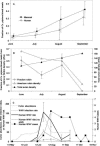West Nile virus epidemics in North America are driven by shifts in mosquito feeding behavior
- PMID: 16494532
- PMCID: PMC1382011
- DOI: 10.1371/journal.pbio.0040082
West Nile virus epidemics in North America are driven by shifts in mosquito feeding behavior
Abstract
West Nile virus (WNV) has caused repeated large-scale human epidemics in North America since it was first detected in 1999 and is now the dominant vector-borne disease in this continent. Understanding the factors that determine the intensity of the spillover of this zoonotic pathogen from birds to humans (via mosquitoes) is a prerequisite for predicting and preventing human epidemics. We integrated mosquito feeding behavior with data on the population dynamics and WNV epidemiology of mosquitoes, birds, and humans. We show that Culex pipiens, the dominant enzootic (bird-to-bird) and bridge (bird-to-human) vector of WNV in urbanized areas in the northeast and north-central United States, shifted its feeding preferences from birds to humans by 7-fold during late summer and early fall, coinciding with the dispersal of its preferred host (American robins, Turdus migratorius) and the rise in human WNV infections. We also show that feeding shifts in Cx. tarsalis amplify human WNV epidemics in Colorado and California and occur during periods of robin dispersal and migration. Our results provide a direct explanation for the timing and intensity of human WNV epidemics. Shifts in feeding from competent avian hosts early in an epidemic to incompetent humans after mosquito infection prevalences are high result in synergistic effects that greatly amplify the number of human infections of this and other pathogens. Our results underscore the dramatic effects of vector behavior in driving the transmission of zoonotic pathogens to humans.
Figures


Comment in
-
A new model for predicting outbreaks of West Nile virus.PLoS Biol. 2006 Apr;4(4):e101. doi: 10.1371/journal.pbio.0040101. Epub 2006 Feb 28. PLoS Biol. 2006. PMID: 20076549 Free PMC article. No abstract available.
References
Publication types
MeSH terms
Substances
Grants and funding
LinkOut - more resources
Full Text Sources
Other Literature Sources
Medical

